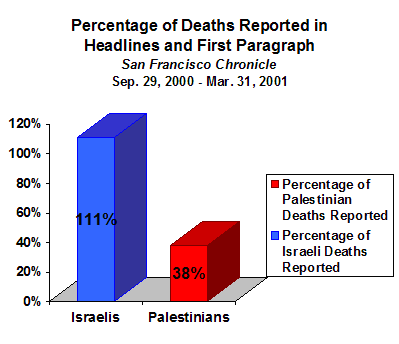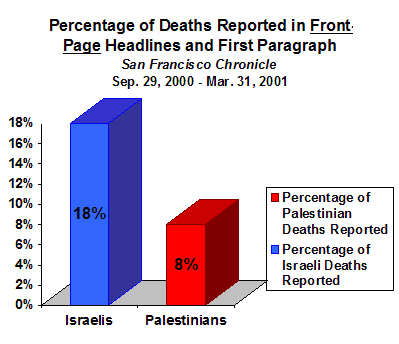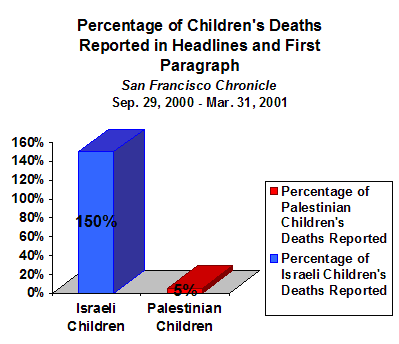

Media Report Card
Accuracy in Israel/Palestine Reporting
San Francisco Chronicle
September 29, 2000 - March 31, 2001
|
|
Download Report
Download Brochure
Abstract
Introduction
Methodology
Coverage of Casualties
Front-Page Coverage of Deaths
Coverage of Children’s Deaths
Coverage of Cumulative Totals
Coverage of the US Connection
Conclusion
Endnotes
Appendices
Abstract
This study consists of a statistical examination of the San Francisco Chronicle’s news coverage of the first six months of the current Palestinian uprising: Sept. 29, 2000 through March 31, 2001. The categories examined were coverage of deaths and injuries in general; children’s deaths; and the U.S. connection to this conflict, U.S. aid to Israel/Palestine.
Our findings indicate significantly inaccurate coverage by the San Francisco Chronicle of these topics. We found a vast disparity in the likelihood of a death receiving coverage based on the ethnicity of the person killed. For the first six months of the current uprising, the San Francisco Chronicle reported on 111% of Israeli deaths and only 38% of Palestinian deaths in the headlines and/or the first paragraphs of the 251 articles on the topic.
This discrepancy was even more exaggerated in the Chronicle’s coverage of the killing of children. During the six- month study period, Palestinian children were being killed at a far higher rate than Israeli children — 27 % of Palestinians killed were under 18 (93 children), while only 6 % of Israelis killed were minors (4 children). Yet Chronicle headlines and/or first paragraphs reported the killing of only 5 Palestinian children, while headlines and/or first paragraphs reported 6 Israeli children killed (one Israeli teenager’s death was reported three times).
In other words, the Chronicle covered 150 % of Israeli children's deaths and only 5 % of Palestinian children's deaths, giving readers the impression that approximately equal numbers of youths had been killed on both sides. Thus, while the death of an Israeli child was prioritized above the killing of an adult, the killing of a Palestinian child was de-prioritized, despite the abnormally high percentage Palestinian children made up of the casualties. One would expect the fact that Palestinian children constituted such a high percentage of deaths to have been considered newsworthy in itself, not the reverse.
Regarding Chronicle coverage of cumulative totals, information that would have at least somewhat ameliorated the above misimpressions, we found that only 12 stories (or 4.8 %) of 251 news stories on this topic contained cumulative totals of deaths on both sides somewhere in the article. There was not a single report on the total number injured.
Finally, only 1.2 % of stories about Israel/Palestine contained information about U.S. aid to Israel and the Palestinians, despite the fact that such aid is an integral factor in the current conflict, and that aid to Israel accounts for approximately 30 percent of total U.S. international aid expenditures.
We are providing our findings to the San Francisco Chronicle in the hope that it will help them to fulfill their goal of accurately reporting the news. We are also providing this study to readers to help them evaluate the Chronicle as a source for understanding the Israel/Palestine conflict in all of its complexities.
Introduction
Beginning in 2003, If Americans Knew1 began issuing a report card to major media across the country on their coverage of the Israeli-Palestinian conflict. This study of the San Francisco Chronicle covers the first six months of the current uprising (September 29, 2000 through March 31, 2001). We chose this particularly significant period because it set the context within which all subsequent reporting on the conflict is viewed.
Given that the media have a desire and a responsibility to cover this topic accurately, we provide these reports in the hope that our analyses can assist them in this goal.
In addition, we are making these reports public, as a way to help readers evaluate for themselves the reliability of their sources of information on this issue.
The goal of this report is to
- Establish agreed-upon standards for assessing accuracy in reporting
- Provide, in a consistent format, an assessment of the publication’s accuracy in reporting on the Israel/Palestine conflict.
Methodology
We recognize that reporting on Israel/Palestine has been an exceptionally controversial topic. Therefore, while there are many potential yardsticks for measuring accuracy, we chose criteria that would be universally acknowledged to be highly significant and not be construed as at all subjective.
1. Coverage of Casualties
We counted the number of Israeli and Palestinian deaths the San Francisco
Chronicle reported on:
- In absolute numbers, and
- As a percentage of total deaths for Israelis and Palestinians respectively. We broke these numbers down into three specific categories:
- All headlines and/or first paragraphs
- Front-page headlines and/or first paragraphs only
- Children’s deaths reported in all headlines and/or first paragraphs. (No children’s deaths were reported on the front page).
- The number of times that cumulative totals of deaths and injuries were reported
We chose this yardstick because it is simple, quantitative and relatively immune to subjective interpretation. In addition, we wanted to discover whether the San Francisco Chronicle demonstrates even-handed respect for human life, regardless of ethnic or religious origin. Finally, because headlines are often among the most prominent aspects of coverage that the reader absorbs, we believe they play a disproportionate role in generating an overall impression about the conflict and the relative consequences for Israelis and Palestinians.
Additionally, we chose to count the number of times the Chronicle provided its readers with the total number of Israelis and Palestinians killed and injured because, given the ongoing nature of daily news reporting, an understanding of the overall context may be lost without such cumulative totals being periodically reported as accurately as possible.
2. U.S. Connection
Finally, we looked at how often the specific American connection to the conflict — U.
S. aid to Israel/Palestine — was covered fully and accurately. We counted the number
of times such aid was mentioned, and then evaluated whether the sum reported was
accurate; for example, whether aid to Israel reported both major segments of U.S.
assistance — military and foreign aid — as well as additional subsidies such as loan
forgiveness programs (see Appendix B).
Coverage of Casualties
For the first six months of the current uprising, 72 San Francisco Chronicle headlines and/or first paragraphs reported on Israeli deaths. During this time, there had actually been only 65 Israelis killed (the discrepancy is due to the fact that a number of Israeli deaths were reported multiple times).
During the same six-month period, 129 reported on Palestinian deaths were reported in headlines and/or first paragraphs. During this time, 343 Palestinians had actually been killed. 2
The total numbers of Israeli and Palestinian deaths were obtained from the Israeli human rights organization B’Tselem.
Figure 1

|
In other words, 111% of Israeli deaths and only 38% of Palestinian deaths were reported in San Francisco Chronicle headlines and/or the first paragraph of relevant articles.
Figure 2

|
Front-Page Coverage of Deaths
For the first six months of the current uprising, 12 Israeli deaths were reported in the headlines and/or first paragraphs of the San Francisco Chronicle articles on the Israel-Palestine conflict. This constituted 18% of Israeli deaths.
Twenty-eight Palestinian deaths, or 8% of the total Palestinians killed, were reported in front-page headlines and/or first paragraphs.
In other words, Israeli deaths were given front-page prominence at a rate over twice that of Palestinian deaths.
Figure 3

|
Coverage of Children’s Deaths
For the first six months of the current uprising, 6 Israeli children’s deaths were reported in the headlines and/or first paragraphs of the San Francisco Chronicle articles on the Israel-Palestine conflict, compared with 5 Palestinian children’s deaths. (Children are defined as those that are 17 and below).
Figure 4

|
According to B’Tselem, during this time, there were actually 4 Israeli and 93 Palestinian children killed.3 Based on these totals, it is clear that, during this period, Palestinian children were being killed at a much higher rate than Israeli children. Children’s deaths accounted for 27% of the Palestinians killed, while children’s deaths accounted for only 6% of Israelis killed during this period.
Figure 5

|
The next chart summarizes the reporting of children’s deaths for the whole six months. It compares the number of deaths reported in headlines and/or first paragraphs to the number of deaths omitted, for Israelis and Palestinians respectively. While only 4 Israeli children were killed during the study-period, every one received prominent coverage, and one received such coverage twice. In contrast, the killings of almost 90 of the Palestinian children merited no such headline coverage.
Figure 6

|
* There were actually only 4 Israeli children killed during the first six months of the current uprising. One Israeli child’s death was reported in three different headlines.
In other words, 150% of Israeli children’s deaths and only 5% of Palestinian children’s deaths were reported by the San Francisco Chronicle in headlines and/or the first paragraph of relevant articles.
Figure 7

|
Coverage of Cumulative Totals
During the first six months of the current uprising, the San Francisco Chronicle reported the total number of Israeli and Palestinian deaths in 12 out of 251 news articles (or 4.8% of news articles) on the Israel-Palestine conflict. During this period, Palestinians were being killed at a rate approximately 5.3 times greater than Israelis.
The Chronicle never reported the total number of injuries broken down by who was injured. Only once did the paper venture into this territory: in an article nine days into the conflict, paragraph 15 stated that there had been “...more than 2,000 injured, the vast majority of them Palestinian.” [Oct. 8, 2000, “Barak: ‘This is a turning point’: Israel prime minister threatens to use greater force, issues warning to Arafat”]
Figure 8

|
Coverage of the US Connection
During the six-month study period, the San Francisco Chronicle reported partial information about U.S. aid to Israel/Palestine three times out of 251 articles (or in 1.2% of the stories) on the conflict. Never was the information provided full and accurate (see Appendix A - Tally Sheet B, and Appendix B).
Figure 9

|
Conclusion
We are concerned about the results of this examination. We believe the readers of the San Francisco Chronicle, as well as all Americans, are entitled to full and accurate reporting on all issues, including the topic of Israel/Palestine.
Given that the Chronicle had ample coverage of this issue (251 stories), it is troubling that so much critical information for American readers was so minimally reported. Further, our findings suggest a pattern of distortion in San Francisco Chronicle coverage of the Israeli-Palestinian conflict inconsistent with normal journalistic standards.
Such a pattern of distortion, in which readers were given the impression that the Israeli death rate was greater than it was, and that the Palestinian death rate was considerably smaller than its reality, may serve to misinform readers rather than inform them.
In particular, our study showed immense distortion in the coverage of children’s deaths. By covering nearly identical numbers of Israeli and Palestinian children’s deaths in headlines and/or first paragraphs, the paper suggested an equivalency in death rates for the two groups, when in actuality over twenty times more Palestinian children had been killed during this period, over 90 percent of them before the first Israeli child’s death.
Such coverage, in which virtually equal numbers of Israeli and Palestinian children’s deaths were given prominence, may give Chronicle readers an impression of balanced reporting that an examination of this six-month period does not justify.
We assume that the San Francisco Chronicle is as disturbed as we have been to find these shortfalls in its quest to provide excellent news reporting to its readers. Now that it has been alerted to these distortions in its Israel-Palestine coverage, we encourage the Chronicle to undertake whatever changes necessary to provide accurate news coverage of this vital issue. We hope that our next report will show an improvement. We will be pleased to report this to the public.
Endnotes
- If Americans Knew is dedicated to providing full and accurate information to the American public on topics of importance that are underreported or misreported in the American media. Our primary area of focus at this time is Israel/Palestine.
- These numbers do not include Palestinians civilians who died as a result of inability to reach medical care due to Israeli road closures, curfews, etc. The figure for Palestinian deaths is extremely conservative given that it was difficult for this organization to report on deaths in the Palestinian territories. Palestinian medical organizations report a higher number for this period. For example, the Palestine Red Crescent Society, internationally respected for its statistical rigor, reports that 409 Palestinians were killed during this time.
- These numbers do not include Palestinians children who died as a result of inability to reach medical care due to Israeli road closures, curfews, etc. The figure for Palestinian deaths is extremely conservative given that it was difficult for this organization to report on deaths in the Palestinian territories. Palestinian medical organizations report a higher number for this period.
Appendices
Download Appendix A - Tally Sheet A: Deaths Reported
Download Appendix A - Tally Sheet B: U.S. Aid Mentions
Download Appendix B
Download a brochure summarizing our findings: U.S. Aid References
If you have trouble with these downloads, contact us.
| Media Report Cards |
Off the Charts: ABC, CBS, & NBC |
Off the Charts: New York Times |
| Related Organizations |
| Stay Informed |
|
Sign up for our mailing list and receive an email whenever we post a new article on our news site, Israel-Palestine News. |
This website is printer-friendly. Please Print this article and share it with your friends and family.


